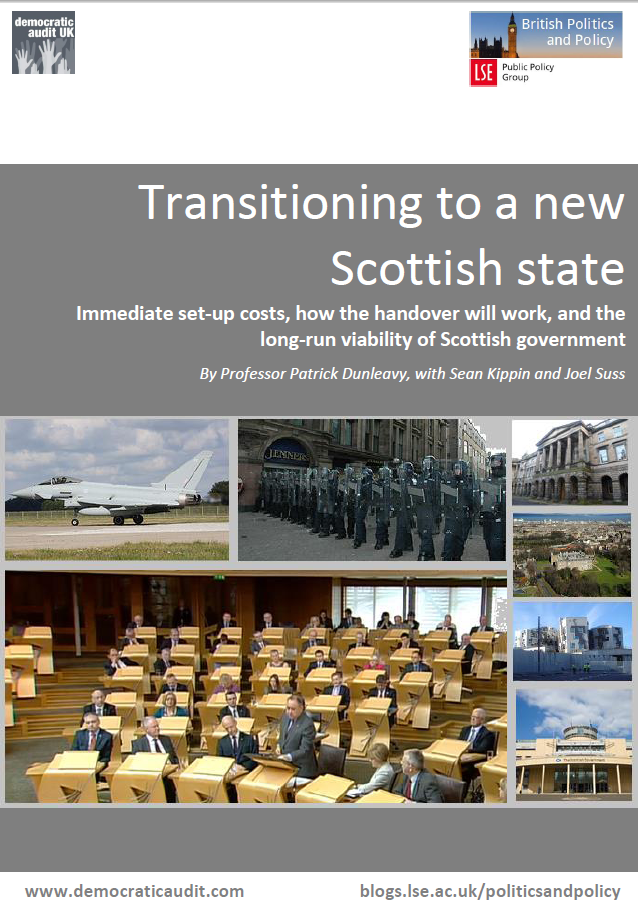How costly would it be for Scotland to transition to independence?
With the referendum on Scotland’s future fast approaching, Patrick Dunleavy examines how costly it would be to set up an independent Scottish state. Coinciding with an op-ed written in The Sunday Post and re-posted on the LSE Politics and Policy Blog, this article outlines the main points of a longer report which can be downloaded here.
Voters in Scotland face a momentous choice on 18 September, of what kind of state they would prefer. How the UK state works is very well known. But how a fully independent Scottish state would work, and how costly it would be to set up, has created a lot of concern, even dread in some quarters.
 Our report essentially shows that the Scottish government has put in place a timetable for transition that is demanding but feasible. We can say with some confidence that Scotland’s immediate set-up costs are likely to be constrained –we suggest around £200 million in one-off costs to create its own versions of a few but big and important existing UK department capabilities.
Our report essentially shows that the Scottish government has put in place a timetable for transition that is demanding but feasible. We can say with some confidence that Scotland’s immediate set-up costs are likely to be constrained –we suggest around £200 million in one-off costs to create its own versions of a few but big and important existing UK department capabilities.
The UK Treasury has suggested that Scotland could also face IT and new administration costs in taxation and benefits,of perhaps as much as £900 million. But these would be systems that come on line only in 2018 to 2021, and they would endure for many years. They hence take on the character of investments, where future running cost savings would also be sought.
Scotland’s transition costs could be kept low by the Edinburgh government contracting with UK agencies to keep back office services being supplied. There are also likely to be some savings that could offset transition costs:
- Some significant ‘streamlining’ savings are feasible initially. We calculate that 206 UK bodies covering Scotland could easily be pruned to just 135 new bodies, 60 of which are very small.
- Many ‘legacy’ UK complexities could be eliminated through modernization – such as the very tangled back-office computer networks in UK tax and benefits systems.
- Comparative evidence suggests that the process of managing a smaller government machine is generally easier, making for fewer large policy disasters than have tended to occur in the UK.
- Some substantial policy savings could accrue in areas such as defence.
The two absolutely critical influences on Scotland’s likely overall transition costs are:
- the realism of Scottish government planning for independence, which generally seems high. However, it does assume that a moderate and rationalist approach will be taken by the government in Westminster; and,
- the stance that London ministers would actually take in negotiations over the transition, which remains largely undefined.
None of these conclusions offer any positive reasons for voters to choose Yes or No, for that was not our purpose. Just because a step might be feasible, and not too costly, is not in itself a reason to take it. Scotland’s voters will make up their own minds what to do, and for their own reasons. But they can be broadly confident that, whatever the majority decides, future Scottish government will be generally effective and well organized.
—
This post represents the views of the author and not those of Democratic Audit or the LSE. Please read our comments policy before posting. The shortened URL for this post is: https://buff.ly/1nXIc4d
—
Patrick Dunleavy is Co-Director of Democratic Audit, Chair of the LSE Public Policy Group, and a Professor of Political Science at the LSE.






 Democratic Audit's core funding is provided by the Joseph Rowntree Charitable Trust. Additional funding is provided by the London School of Economics.
Democratic Audit's core funding is provided by the Joseph Rowntree Charitable Trust. Additional funding is provided by the London School of Economics.
How costly would it be for Scotland to transition to independence? : Democratic Audit UK https://t.co/sixZbEF3zV
Must read! My colleague @PJDunleavy on independent #Scotland start up costs. £200 million to set up key departments https://t.co/NWxkmXbWyB
RT @PJDunleavy: How costly would it be for #Scotland to transition to independence? #indyref https://t.co/9YGO7xHj4F
How costly would it be for Scotland to transition to independence? https://t.co/Jgw2rtZxZ1
The biggest potential issue would be if they do as Eire did and continue the Civil Service with it’s current pay and conditions. Scotland simply will not have the wherewithal. This has been the biggest problem economically since the foundation of the Irish State in 1922. That and a profound unwillingness to tax harvest properly.
How costly would it be for Scotland to transition to independence? https://t.co/MAarDPWdL2